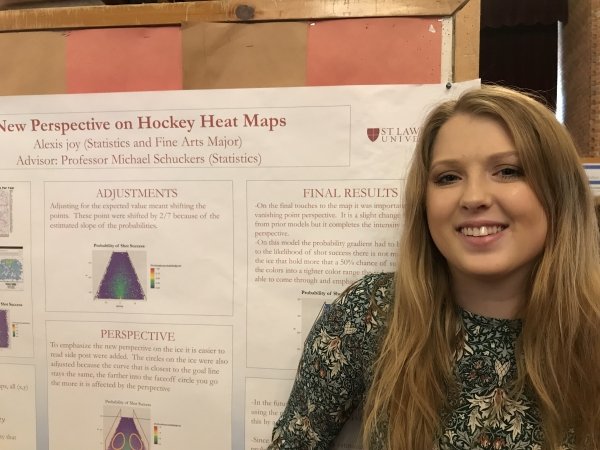
Festival of Science 2019 - Student Abstracts
Festival of Science was held Friday, April 26, 2019.
Seongwon “Ryan” Im, Faculty Sponsor Patti Lock, Mathematics
“Crowdsourcing and Racist Soccer Referees”
Abstract: Is there evidence of racism in calls made by soccer referees? If so, is it possible to prove a cause-and-effect relationship? Soccer is a universal, wide-world sport that anyone can easily participate. Thanks to this, most nations are part of the soccer community and compete against each other. Unfortunately, while such soccer competitions must retain impartiality and unbiasedness, numerous factors can sabotage soccer matches. One potential factor is a biased call made by a racist soccer referee. One research project elected to study this through crowdsourcing with analysts from different professions. Surprisingly, using identical data did not guarantee an identical outcome. Each of the 29 analysis teams used their own statistical method and approach to address the question. We examine these methods while also presenting our own analysis of the data. In this project, we look at the presence of racist referees while also addressing how easy it is for one set of data to point to different conclusions.
Alexandra Withee, Faculty Sponsor Robin Lock, Statistics
“A Shiny App for Visualizing 100 Years of Adirondack River Data”
Abstract: The USGS collects data on discharge rates for many rivers including several in the Adirondack region. We have monthly data going back as early as 1908 for 23 sampling sites. Our goal in this project is to create a web application to aid geologists in the visualization and analysis of these time series data. We use the Shiny platform in R to build tools to plot the data in various forms. We enhance these visualizations with techniques such as simple exponential smoothing, seasonal and simple linear regression models, Holt Winters smoothing, and a monthly spaghetti plot to investigate and highlight trends in the data.
Anna Breton, Germaine Garcia, and Kayleigh Reid, Faculty Sponsor Ed Harcourt, Computer Science
“Ghost Busters, An Android App.”
Abstract: We implemented an interactive augmented reality Android mobile game. Similar to Pokemon Go, our app includes features such as GPS tracking and distance measurements, camera, speakers, and WiFi connection. The main goal of the game is for users to explore their environment and “capture” ghosts as they appear on the user’s android device within a limited time frame.
Emily Casey-Wagemaker, Faculty Sponsors Daniel Look, Jessica Sierk, Patti Frazer Lock, Mathematics
“Deconstructing discipline: A mixed methods analysis of disciplinary policies in New York State’s Capital District”
“Abstract: Current data show large disparities in disciplinary actions experienced by students of color as opposed to their White classmates. Discourse and policy language in school codes of conduct can reflect the endemic nature of racism in society, which, in turn, negatively impacts students of color. Utilizing statistical, sentiment, and critical discourse analysis, this mixed methods research provides a more complex view of the impact of policy on the disproportionality of discipline in schools. This research examines how racism and classism interact with discipline in schools and how this contributes to high dropout rates and the school-to-prison pipeline.
Xizhao Liu, Faculty Sponsor Daniel Look, Mathematics
“Robinson or Doyle? Authorship attribution for ‘The Hounds of Bakersvilles”
Abstract: This poster is about authorship attribution of “The Hound of the Baskervilles”, the third of four novels by Sir Arthur Conan Doyle featuring the detective Sherlock Holmes. After its publication, the novel gained instant success, but controversy came after. There were some claims that Bertram Fletcher Robinson, a very close friend of Conan Doyle, coauthored the book, in some accounts writing the entire first section. We will discuss some stylometric techniques, including cluster analysis, consensus trees, and Burrow’s Delta, and then discuss the results from applying these methods to “The Hound of the Baskervilles.”
Brian Silfer, Faculty Sponsor Jessica Chapman, Statistics
“The Stats of Music: A Look at both Film and Spotify Data”
Abstract: This poster presentation highlights how data-rich film and music can be through two illustrative analyses. First, we investigate how variables grounded in film theory could be predictive of the success of Oscar-nominated films (in the category of Best Picture). Measures of success investigated include winning Best Picture, critics’ ratings, and popular ratings. In the second analysis, I apply clustering techniques to data from the Spotify API to investigate several musical elements and how those elements are shared between songs.
Shyanne White, Faculty Sponsor Jessica Chapman, Statistics
“The Thriving Student”
Abstract: The Thriving Quotient has been a recent method to measure academic, social, and psychological components of a student’s college experience. These components include engaged learning, academic determination, positive perspective, social connectedness, diverse citizenship, sense of community, spirituality, and campus involvement, among other factors. For this project, preliminary Thriving Quotient data for SLU students was examined. Hierarchical clustering, with Ward linkage, was used to identify clusters of students who “thrive” (or not) in different ways. These clusters, or groups, are then linked back to retention and other data to investigate the relationships between “thriving” in different ways and success at SLU.
Alexis Joy, Faculty Sponsor Michael Schuckers, Statistics
“Remapping NHL Shots”
Abstract: Heat maps are commonly used in the field of sports analytics. They can be a quick and easy way to read plays and find hot spots in activity. The goal of this project was to make the heat map for data from the National Hockey League (NHL) more appropriate for the visual assessment of information about shots and their location. We utilized data from recent NHL seasons and adjusted the map to ensure that visual assessment of shot impact was appropriate. To do this we adjusted the width of the rink for the heat map to match the probability of a goal from that location. The heat map then has perspective which allows the viewers eye to focus on the more important/useful probability spikes on the ice. To emphasize the perspective, we created an atmosphere around the map to define the rink. After completing the project, we applied it to large data sets to assure accuracy.
Ken Schimpf, Faculty Sponsor Ed Harcourt, Computer Science
“Optimizing Technical Indicators for the Algorithmic Trading”
Abstract: In modern financial markets, predicting asset value with speed and accuracy is the ultimate goal of algorithmic trading. As market analysis has transitioned to algorithms and analytics, identification of entrance and exit positions for financial trades has risen to the forefront of asset trading strategies.
The price movement of a financial asset can be examined using a variety of statistical indicators which identify trends, momentum, and volatility. Technical indicators, such as moving average crossovers and the relative strength index analyze historical data to predict potential bullish and bearish signals. It is common trading practice to incorporate multiple indicators to develop a financial thesis for determining asset trades that will yield a profit. Utilizing algorithms allows traders to implement and execute their financial thesis quickly and accurately.
This program backtests and optimizes three technical indicators on historical intraday minute bar asset prices to execute trades which identify effective indicator parameters yielding the highest profit for a given equity.
Sarah Campbell, Faculty Sponsor Michael Schuckers, Statistics
“Elements of Data Storytelling”
Abstract: The goal of this project is to detail the necessary elements of a data analysis report and to explain how to write about them effectively. The necessary elements of a report are: 1. A specific story; 2. The results and conclusions of the analysis; 3. A discussion of the analysis; 4. The methods used for the analysis and how the data was collected; and 5. The context of the study. Each of these elements contributes to an audience’s ability to understand the analysis and its significance easily and completely. The paper also addresses how to format and structure these elements to create a cohesive, effective and impactful report. In response to Jane Miller’s format for data analysis reports, the GEE: Generalization, Example, Exception, the paper suggests reversing the first two components to create the format EGE: Example, Generalization, Exception. Due to evidence in psychology, beginning with an anecdote or story, i.e. a specific narrative that creatively exemplifies the results, is more effective for immediately engaging and convincing an audience of an analysis’s results.
Sarah Strong, Faculty Sponsor Ivan Ramler, Statistics
“Systematic Gender Bias in League of Legends”
Abstract: Released in October 2009 by Riot Games, League of Legends is a multiplayer online battle arena game. Typically played in teams of five, each player picks a champion to take on either the role of Top, Middle, Jungler, AD Carry or Support. The over 100 champions in the game can be broadly categorized into male, female and monster. For the purpose of our research, we wanted to determine if there was a systematic gender bias in the way the male and female characters are created and played, making one gender always a better option to play a specific role. Using linear models, we used game statistics from 2015 gender and role to predict the estimates of 16 individual statistics for each champion. We then analyzed this data to see if there were any dramatic differences in the statistics between males and females.
Cameron Dehais, Faculty Sponsor Patti Frazer Lock, Mathematics
“Nickelodeon Fan Polls under Various Voting Methods”
Abstract: Amid national discourse about voting systems in the United States, Maine’s 2nd Congressional District made history with an election decided by ranked-choice voting. Coupled with a tournament-style series of polls conducted by fans of the television network Nickelodeon, this raises questions as to how voting tabulation methods can sway election outcomes. This paper seeks answers to these questions via original survey data. Through two separate rounds of polling, data were collected to gain insight into Nickelodeon fans’ preference of cartoons airing in the 1990s and early 2000s. Multiple distinct tabulation methods are used to count these votes and determine which Nicktoons are fans’ definite favorites.
Paloma Rulz, Faculty Sponsor Maegan Bos, Mathematics
“Evariste Galois”
Abstract: Éveriste Galois was a French mathematician, born shortly after the end of the French Revolution. Galois is often credited for discovering group theory as well as being known for his political activism. This project dives into his life and the influence the French revolution had on it, as well as understanding his contributions to mathematics.
Christopher Roy, Faculty Sponsor Ed Harcourt, Computer Science
“Creating Self-Securing Files”
Abstract: This project presents a new kind of self-securing file. The files each contain two sections, one section containing all of the content, and the second section a program written, in Python, by the creator of the file. This program controls access to the file. The file type uses a special text editor that allows the user to create both sections. The program written in the files can use all of the Python programming language. For example, the user could create a new file type for files that are designed to only be read once and then self-destruct. Another type of file could have a delayed access, where the user was not allowed to read it until a specific date and time.
Travis Marnell, Faculty Sponsor Patti Frazer Lock, Mathematics
“How Math is Solving the Issue of Gerrymandering”
Abstract: Gerrymandering is an issue that arises when states unfairly divide the state into congressional districts. A district must fit within three criteria: equal populations, contiguous, and compact. The compactness of each district is the main complication when it comes to mappings. We will discuss mathematical measures of compactness. In addition, we will discuss how mathematics has been used in recent court cases involving gerrymandering to help solve the issue at hand.
Joseph DeGuardia, Faculty Sponsor Michael Schuckers, Statistics
“Predicting NFL Division Standings”
Abstract: Each year some teams in the National Football League (NFL) improve and some decline and predicting these changes is the goal of this project. In the NFL, there are 32 teams split up into 8 divisions, with 4 teams in each division. The goal of this analysis is to predict the order in which each division will finish. Since the only thing we are interested in is predicting the order teams will finish and not their exact wins and losses, I am going to use ordinal regression to do this. Ordinal regression will generate an “order” that these teams are expected to finish. I am using data from pro-football-reference.com for this model. As predictors I will use, the previous season win percentage, red zone percentage (offensively and defensively), turnover ratio, and the upcoming years strength of schedule. This model will include data from the previous 3 NFL seasons to generate predictions.
Dylan DeChiara and Stefanos Kalamaras, Faculty Sponsor Ed Harcourt, Computer Science
“Wi-Fi Direct Multiplayer Air Hockey”
Abstract: For our project we created a two player network Android based air hockey game. The network connection is a peer-to-peer Wi-Fi direct communication link between two Android tablets. . The goal of the project was to better develop our understanding for client and receiver communication along an over-the-air buffered input/output stream. Our game includes the ability for two players to play against each other on two separate devices in a competitive setting. Paddle and puck location are synchronized and updated in real-time between the devices. The game follows the classic air hockey rules, however the client is able to provide alternative parameters before the game is created. Alternative parameters include, goal size, number of goals to win, and time allotted per game. We wanted to bring the classic air hockey experience to the user while also giving them the freedom to make the game what they want it to be.
Xizhao Liu, Faculty Sponsor Maegan Bos, Mathematics
“Pierre-Simon Laplace”
Abstract: In this poster, I will introduce Pierre-Simon Laplace’s background, including his early life, his connection with French revolution, fundamental researches and contributions to the areas of mathematics, probabilities and engineer. And then I will include Laplace’s theorems, for example, Laplace Equation and Laplace Transformation, which are both named after him.
Zeyu Lu, Faculty Sponsor Daniel Look, Mathematics
“Knot Theory, the Jones polynominal, and graph theory”
Abstract: Knot theory is the study of mathematical knots. A main focus is whether two knots are the same even though they may appear different. Knot invariants play an important role in answering this question. One of the most interesting and successful types of invariants are knot polynomials. These involve associating polynomials with knots. We investigated several knot polynomials, including the Jones polynomial, as well as how we can relate these to graph theory.
Currie Smith, Faculty Sponsor Maegan Bos, Mathematics
“Mathematical Revolutions: Blaise Pascal”
Abstract: Blaise Pascal grew up during one of the largest mathematical revolutions in history: The Age of Enlightenment transformed the intellectual landscape of Europe. While growing up and collaborating with other mathematicians such as Pierre Fermant, René Descartes, Gérard Desargue, Gilles Personne de Roberval, Isaac Newton, and others, Blaise Pascal made some of the most impressive mathematical improvements of all time. Along with being a mathematician, Blaise Pascal was also known as a physicist, a religious philosopher, and a master of prose. For this project I have examined one of Pascal’s discoveries: the algorithmic triangle known as Pascal’s Triangle, and how it was informed by the time he lived. In doing this I have examined how the triangle is used in simple addition all the way to complex probability concepts. Thus, helping the argument that Pascal has become one of the most well-known mathematicians of all time.
Taylor Digilio, Faculty Sponsor Robin Lock, Statistics
“Siny App for Accessing and Visualizing MLB Pitch Data”
Abstract: Major League baseball collects data on over 80 variables for every pitch thrown in every game in the major leagues. We created a web application to allow users to easily access this database and summarize information about their favorite players or matchups. Users can control the batter, pitcher, or date range to select data from the 2018 season. After selecting the data, the user can toggle between various graphs to visualize aspects such as pitch locations, pitch movements/speeds, along with results and types of pitches. At any stage the user can download a version of the data for their own use.
Grace Harrison, Faculty Sponsor Michael Schuckers, Statistics
“What Type of Roster Depth Do NHL Teams Need?”
Abstract: In the salary cap era of the NHL, evaluating which parts of a team’s roster can best help generate a post season berth could provide insight to organizations on where they should invest. Novet (2017) proposed that hockey was a strong link sport meaning that a team can be as good as their best player rather than a game like soccer where you can only be as good as your worst player. We have extended this work using three different responses from five regular seasons for the impact of a player Fenwick, THoR and X Shot are varying multiple regression models that generate an adjusted “plus minus” type proxy for individual NHL players, Schuckers and Curro (2013). By constructing quantiles and evaluating basic estimates such as max, min, mean, median, range and Gini we assessed the impact certain team structures could have on regular season points. The three different proxies generated different results regarding what parts of a team would help the most but ultimately, we agreed with Alex Novets sentiment that for a team to do well they need the top players to help set the tone on their teams.
Eliza Oliver, Faculty Sponsor Patti Frazer Lock, Mathematics
“Using Game Theory to Examine the Effects of Prejudice”
Abstract: While prejudice and hatred continue to permeate the American public through media and prominent public figures, the need for unity has never been greater. Understanding the effects of intentional and inadvertent prejudice is the first step toward finding a solution for this unnecessary conflict. The Prisoner’s Dilemma studies strategies for iterative decision making between two parties. It has applications to business and economics, psychology, and international relations. Through the discussion of various strategies players can employ in the Prisoner’s Dilemma, we can see how cooperation with others and defection against can enhance the effects of prejudice in a society. Focusing on the most prominent strategies, including Tit-for-Tat, and considering various conditions of the environment, we will be able to further understand prejudice and discuss efforts that can be made to further reduce the spread of prejudice.
Nicholas Lynn, Faculty Sponsor Patti Frazer Lock, Mathematics
“How to Pick a Winner”
Abstract: In 1951, Kenneth Arrow proved that no voting method can be entirely fair. However, we still need a way to vote. If we have to pick a flawed method of voting, then the following questions are raised: What are the positive and negative aspects of some common voting methods? What voting method is the least unfair? How should we vote and how should we count those votes? Perhaps more importantly, how can we make voters feel that their votes actually matter. We discuss different voting methods, including examples of current use and implications.
Tomas Cespedes, Faculty Sponsor Michael Schuckers, Statistics
“Market Basket and Support Vector Machines on Cryptocurrency”
Abstract: The cryptocurrency market is a new frontier of trading that has capabilities that have not been explored yet. However, it often falls under immense criticism due to the lack of understanding that the public has. Furthermore, the overall volatility of the market inherently frightens the safer investors. As a result, people are trading coins without proper knowledge and do not understand the technology behind most of these currencies. This means that the public’s perception and ownership of coins could have some correlation with the price of the coins. The lack of understanding causes a societal value to be placed on these coins rather than appraising them for their intended purpose. I have decided to run a market basket analysis on the top 10 “coins” in the cryptocurrency market to see if we can predict market volume and price throughout different time periods (at certain times of the day, per month, per year, etc...).To do this, we can look at trade volume, market cap, daily prices, and more. The goal of Market Basket Analysis is to predict what future customers are more likely to purchase based on previous transactions. We can categorize the data to fit our parameters by determining whether within a certain time frame there is a gain or loss. After performing MB analysis, we compare the results to the results from Support Vector Machine regression. SVM is another classification technique that can map it’s inputs into high-dimensional feature spaces. As a result, I hope to be able to follow economic and social trends (either short or long term) to discover a stable approach to an emerging economy.
Yirong Zhu, Faculty Sponsor Michael Schuckers, Statistics
“Credit Card Fraud Detection”
Abstract: Fraudulent credit card transactions are a problem and many companies and credit cardholders have been negatively affected. Therefore, it is very important to identify false credit card transactions accurately. The purpose of this project is to apply multiple methods to distinguish between fake credit card transactions and real credit card transactions. The data is from Kaggle and it contains 492 frauds out of 284,807 transactions by European cardholders in September 2013. Due to confidentiality issues, the original variables have been masked. I will apply multiple methods to these data with emphasis on Synthetic Minority Over-sampling Technique (SMOTE), an approach to classify imbalanced datasets by increasing the percentage of the minority cases and then identifying the category by combining features of the target cases with features of its neighbors. These methods will be compared based upon their ability to correctly classify these transactions as fraudulent or not.
Francisco Rodriguez-Tineo, Faculty Sponsor Patti Frazer Lock, Mathematics
“Prison Gerrymandering”
Abstract: Gerrymandering is the act of politicians manipulating the redrawing of legislative district lines to help their friends and hurt their enemies (Fairvote). As the era of mass incarceration exploded so did prison gerrymandering. Prison gerrymandering has been inescapable because of the Census Bureau’s “usual residence rule” (Skocpol, 1483). This study investigates the impacts of prison gerrymandering on county political representations and institutionalized racism by analyzing and synthesizing the theoretical and empirical literature dealing with prison gerrymandering. I hypothesize that prison gerrymandering further continues to support institutionalized racism and skews county political representation.
Genevieve Nguyen, Faculty Sponsor Ed Harcourt, Computer Science
“Over Here! An Android app for locating mobile devices”
Abstract: As a multifunctional device, the smartphone has become an essential tool for many people. Since they play an important role in daily communication and storing personal information, losing a smartphone is not only inconvenient but also a risk of leaking private information. Over here! is an Android application that allows users to locate their lost device using another Android device. Over here! provides user authentication via an online Google cloud database called Firebase to ensure that device information can only be accessed by the device owner. The Firebase Realtime Database was implemented to store and retrieve device location as well as user information. Users can either set an alarm to locate the device if it is close, or request the device’s location and get real time location updates as the lost device is moved.
Fulk Connor, Faculty Sponsor Patti Frazer Lock, Mathematics
“Racial Bias in U.S. Prison Sentencing”
Abstract: The United States has the world’s highest incarceration rate at 670 per 100,000 people. Also, the United States prison population has been growing since the 1980s. Only 13.4% of the US population is black but 38.0% of US federal inmates are black. In 2008 and 2009, black people received on average sentences that were 35 months longer than sentences received by white people. We examine these disparities by looking at prison sentence length by race for the same crime.

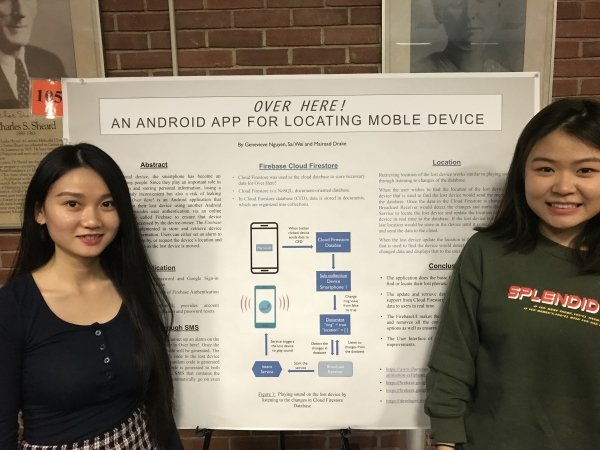
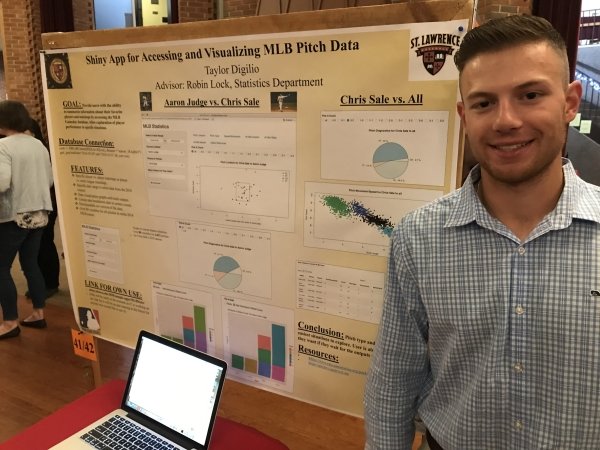
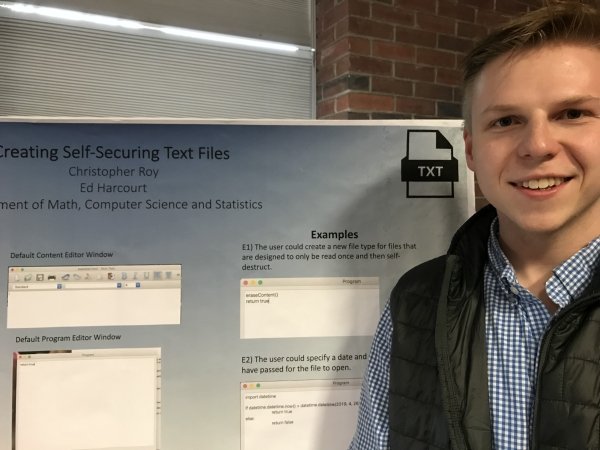
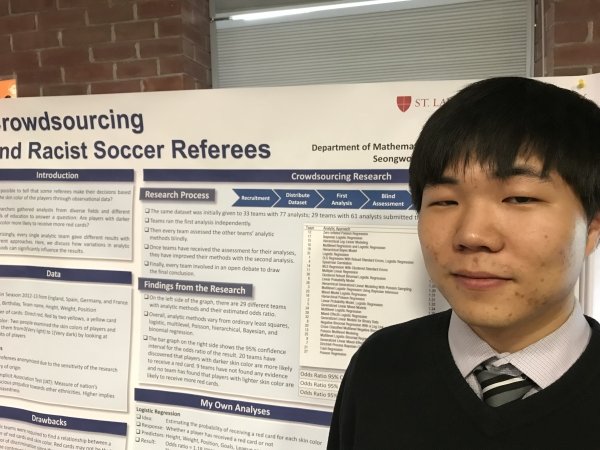
Any changes that need to be made please let Diane Chase know.
